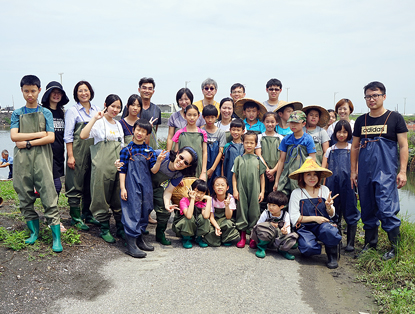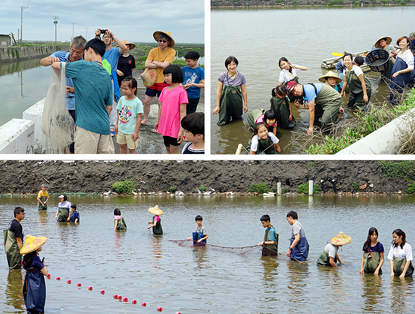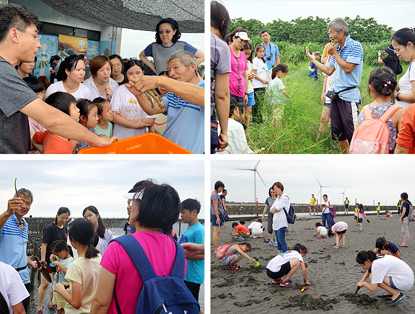Sketch of Archilife Study Tour, April 2019
|
2019年4月份見識之旅縮影  4月份見識之旅活動,於2019年4月20日由呂明澐小姐帶領28位祐生見習生及家長們,進行彰化芳苑海田生態暨一日漁人體驗之旅。出發當日天氣晴朗,見習生們及其家長皆準時集合並出發。活動開始之初,領隊呂明澐小姐提醒本次活動注意事項及觀察重點,先行建立見習生的背景知識。 4月份見識之旅活動,於2019年4月20日由呂明澐小姐帶領28位祐生見習生及家長們,進行彰化芳苑海田生態暨一日漁人體驗之旅。出發當日天氣晴朗,見習生們及其家長皆準時集合並出發。活動開始之初,領隊呂明澐小姐提醒本次活動注意事項及觀察重點,先行建立見習生的背景知識。For the study tour of April 20, 2019, Ms Lu Ming-yun led 28 ARF interns and their parents on a tour of Fangyuan aquaculture farm in Changhua and experienced a day as a fisher. It was clear and sunny on the day of the tour, and the interns and their parents were on time for the departure. At the start of the day's activities, team leader Ms. Lu Ming-yun reminded everyone about things to note and what to observe, and provided the interns some general background knowledge.  上午行程前往位於彰化芳苑的哈哈漁場,漁場主張「自然生態養出來的海鮮最美味」,不單一養殖,讓多種生物自然繁殖,透過物競天擇達到生態平衡,生存下來的才是最強壯健康的產物,本次由漁場主人陳明瞭先生擔任導覽老師。行程一開始,導覽老師帶領眾人認識附近河口生態,說明其魚塭水源來自海水,藉由檢視河口是否有魚蝦存活判斷水質乾淨與否,並以八卦網、蛇籠現場捕撈,讓眾人親眼見證豐富的河口生態。隨即解釋蛇籠使用方式與原理,以分解動作示範手拋八卦網捕魚,鼓勵見習生們動手操作,體驗昔日漁夫賴以維生的重要工具。緊接著,眾人穿著青蛙裝下魚塭進行牽罟體驗,牽罟是傳統漁撈技法,須要密集的人力齊心完成。首先,眾人分兩側拉住大型魚網,待竹筏驅趕魚群進入網中,全體通力合作將魚網收合拉上岸,感受早期漁民團結互助的精神。 上午行程前往位於彰化芳苑的哈哈漁場,漁場主張「自然生態養出來的海鮮最美味」,不單一養殖,讓多種生物自然繁殖,透過物競天擇達到生態平衡,生存下來的才是最強壯健康的產物,本次由漁場主人陳明瞭先生擔任導覽老師。行程一開始,導覽老師帶領眾人認識附近河口生態,說明其魚塭水源來自海水,藉由檢視河口是否有魚蝦存活判斷水質乾淨與否,並以八卦網、蛇籠現場捕撈,讓眾人親眼見證豐富的河口生態。隨即解釋蛇籠使用方式與原理,以分解動作示範手拋八卦網捕魚,鼓勵見習生們動手操作,體驗昔日漁夫賴以維生的重要工具。緊接著,眾人穿著青蛙裝下魚塭進行牽罟體驗,牽罟是傳統漁撈技法,須要密集的人力齊心完成。首先,眾人分兩側拉住大型魚網,待竹筏驅趕魚群進入網中,全體通力合作將魚網收合拉上岸,感受早期漁民團結互助的精神。The morning's itinerary brought everyone to Haha Fish Farm in Fangyuan, Changhua. The fish farm believes that seafood grown in a natural ecological environment is the most delicious. By allowing diverse species of organisms to co-exist and reproduce naturally, ecological balance is achieved as the fittest that survive will be the strongest and healthiest. On this tour, the farm owner Mr. Chen Ming-liao was the tour guide. He began the tour by introducing everyone to the river-mouth ecosystem, explaining that water for the fish farm comes from the sea. The cleanliness of water is determined by survival of fish and shrimps at the river mouth. He also used cast net and fishing net trap to catch fishes, enabling everyone to witness the biodiversity of the river-mouth ecosystem. He then explained how the fishing net trap is used and the principle behind it. He also gave a step-by-step demonstration of casting the fishing net and encouraged the interns to try it out to experience using the important tool fishermen depend on for their livelihood in the past. Next everyone wore wading pants and tried out the traditional fishing method of using Taiwanese beach seine. Divided into two groups, everyone stood on one or the other side of a large fishing net and worked together to drag the net back onto the shore when the bamboo raft had driven the fishes into the net, experiencing the team spirit of fishermen in the past.  午飯享用上午眾人合力捕撈之漁獲,餐點鮮甜可口。飯後,導覽老師介紹蝦子繁殖時期,母蝦抱卵與生理上之變化。解說完畢,即前往漢寶濕地,在導覽老師的帶領下,認識許多潮間帶生物,見習生實際以鏟子挖沙尋找沙蟹,近距離觀察其特徵。接著說明蚵田相關知識和寄生生物,指出牡蠣屬濾食性動物,可淨化水質,牡蠣殼可將二氧化碳轉換成碳酸鈣,固碳能力高,牡蠣礁更是天然的海岸緩衝區,亦提供底棲生物棲息、避難空間。隨後補充一般在海岸線平直、大陸棚平緩且潮汐起伏大之沿海區域養蚵,可供應牡蠣充足養份,也因海水與陸地溫度差異大,當牡蠣感受溫度急遽變化時,認為即將死亡,故會排放大量精卵努力繁殖,最後比較彰化雲林與嘉義台南養蚵差異。整天活動內容豐富精彩,導覽內容有趣生動,見習生們反應熱烈。至此,本日活動已近尾聲,大家一起合照留念後搭車返程,並期待於下次見識之旅再相見。 午飯享用上午眾人合力捕撈之漁獲,餐點鮮甜可口。飯後,導覽老師介紹蝦子繁殖時期,母蝦抱卵與生理上之變化。解說完畢,即前往漢寶濕地,在導覽老師的帶領下,認識許多潮間帶生物,見習生實際以鏟子挖沙尋找沙蟹,近距離觀察其特徵。接著說明蚵田相關知識和寄生生物,指出牡蠣屬濾食性動物,可淨化水質,牡蠣殼可將二氧化碳轉換成碳酸鈣,固碳能力高,牡蠣礁更是天然的海岸緩衝區,亦提供底棲生物棲息、避難空間。隨後補充一般在海岸線平直、大陸棚平緩且潮汐起伏大之沿海區域養蚵,可供應牡蠣充足養份,也因海水與陸地溫度差異大,當牡蠣感受溫度急遽變化時,認為即將死亡,故會排放大量精卵努力繁殖,最後比較彰化雲林與嘉義台南養蚵差異。整天活動內容豐富精彩,導覽內容有趣生動,見習生們反應熱烈。至此,本日活動已近尾聲,大家一起合照留念後搭車返程,並期待於下次見識之旅再相見。Lunch was the fresh and delicious fish caught by everyone in the morning. After lunch, the tour guide explained how female shrimps carry their eggs and their physiological changes during reproduction before bringing everyone to Hanbao Wetland to learn about intertidal living things. The interns looked for sand crabs using shovels and observe their characteristics up close. Next, the tour guide introduced the oyster field and parasitic organisms, pointing out that oysters are filter feeders which can purify water and their shells can convert carbon dioxide into calcium carbonate, which is highly efficient in carbon sequestration. Moreover, oyster reefs are natural coastal buffers, providing bottom dwellers habitat and refuge. The tour guide added that rearing oysters along coastal areas where the shoreline is level, continental shelf is gently sloping, and there is great rise and fall in the tides, will provide oysters with adequate nutrients. Due to the great temperature difference between the seawater and land, the oysters will work hard to release massive amount of sperms or eggs for reproduction when they detect sudden temperature changes as it is perceived as a threat to their survival. The tour guide then concluded by comparing the differences in oyster farming between Changhua/ Yunlin and Chiayi/ Tainan. The entire day has been filled with exciting activities and lively content, getting enthusiastic response from the interns. At this point, the day's itinerary came to an end. Everyone took a group photo before heading back and looked forward to the next study tour. |

